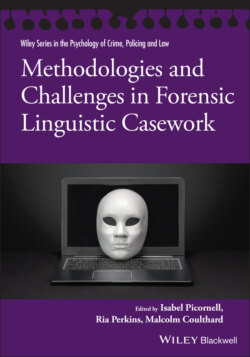Читать книгу Methodologies and Challenges in Forensic Linguistic Casework - Группа авторов - Страница 18
THE FORENSIC LINGUISTIC PRACTITIONER
ОглавлениеAs already stated, there is no regulatory body or a set of required qualifications to become a forensic linguist, although there is ongoing debate and discussion around their professionalization and how clients may be assured as to a forensic linguist’s expertise and the methodologies they employ.
The best methodologies are those that have been identified as valid and reliable. These tend to have at least an element of computational analysis, largely for document comparison in authorship analysis (Chapter 2) and plagiarism (Chapter 6) but also including forensic authorship profiling (Nini, 2018).
However, many documents in forensic contexts tend to be short and therefore not suitable for computational analysis, or the document may not be compatible with the genre of texts on which the technology was originally developed and certainty levels tested. Much of forensic linguistic analysis is described relative to existing linguistic theory to cope with the complexities of language and inconsistencies within linguistic variation between individuals. This descriptive analysis is insightful, based on years of linguistic experience and a wide knowledge base, describing linguistic behavior and interpreting features using established linguistic theories as to how language works under certain circumstances (Chapters 3 and 8). These descriptions may be supported by recourse to online reference corpora allowing for expressions of uniqueness for a particular linguistic feature in a population.
This descriptive approach does not always rest comfortably with expectations of certainty that legal practitioners and the courts have become used to from other forensic sciences, resulting in lawyers and judges not always finding linguistic analysis persuasive. Judges, like linguists, are in the business of interpreting meaning. However, they may not realize that their evaluation of linguistic competency is not the same as a linguistic methodological evaluation; consequently, judges may not always appreciate a linguistic “expert” explaining to them how the language would be interpreted under certain conditions. Forensic linguists are acutely aware of how courts may disagree with their findings, however competent the linguistic analysis (Chapters 3 and 7; also see Coulthard, 1997). Therefore, the success or failure of a case is not always a good indication of how good or bad a linguistic methodology is.
Insistence on conclusion certainties comes with its own problems, such as those associated with black box technology. While there may be certainty regarding the input text data and expressions of certainty regarding the output conclusions, the internal analytical process is opaque. In deep learning systems, calculations are so complex, numerous, and variable that they may not be directly understandable by their own creators. We often do not actually know how much individual features contribute to final outcomes or how accurately the post hoc explanation reflects the actual computational process because calculations are not accessible. It is often impossible to determine whether the “explanation” that analysts provide for the calculations is actually what the black box model processed (Rudin, 2019).
Until forensic linguistics research is able to arrive at a wide range of replicable valid and reliable methodologies, clients and judges need to be able to assess an analyst’s proficiency (Solan, 2020). In the first instance, it is our belief that, as a minimum, forensic linguistic casework analysts should have a PhD and have conducted recent relevant research.
One of the main issues in such casework is being aware of and dealing with confirmation bias. In investigative contexts where clients look to analysts for assistance in guiding the direction of investigations, this may be easier to manage. It becomes more difficult when investigators require confirmation of a suspicion they hold or when requiring reports for trial and analysts are aware of the outcomes their instructing clients would like to achieve. Research demonstrates that people are more likely to gravitate toward the evidence that confirms positions they support and underplay evidence that detracts from it.
One model we have found useful is for linguists to work in pairs: one linguist to act as an intermediary or case manager to coordinate with clients, collect necessary facts surrounding the investigation plus any potential data, and help formulate the linguistic question(s), thereby distancing the second linguist, who undertakes the analysis, from external influences, minimizing the risk of confirmation bias (see Chapter 2). This approach is not always possible, depending on client confidentiality requirements or where analysts are sole practitioners. Aspects of analysis may also rely on knowing some of the sociolinguistic background of suspected authors and their addressees, requiring disclosure of this information to the analyst, as seen in Chapter 8. It is a difficult but necessary balancing act that relies on a professional and informed relationship between analysts and their clients.
